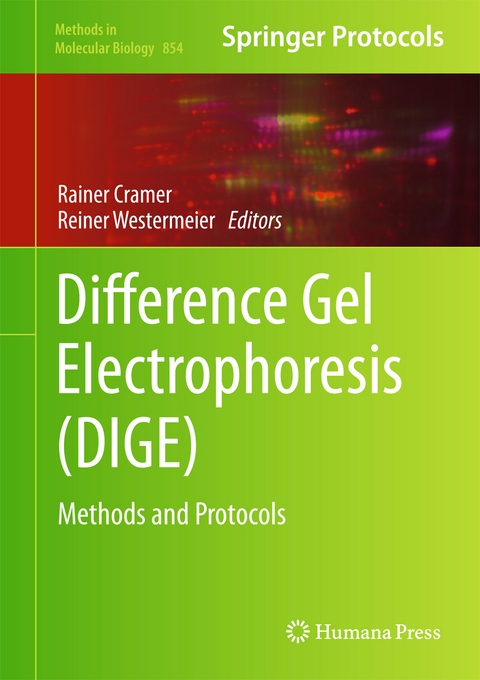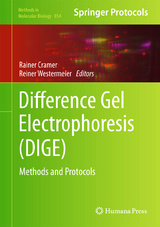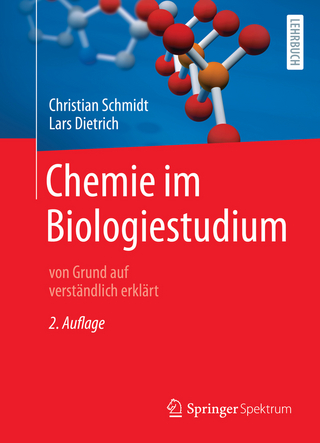Difference Gel Electrophoresis (DIGE)
Humana Press Inc. (Verlag)
978-1-61779-572-5 (ISBN)
Protein analysis is increasingly becoming a cornerstone in deciphering the molecular mechanisms of life. Proteomics, the large-scale and high-sensitivity analysis of proteins, is already pivotal to the new life sciences such as Systems Biology and Systems Medicine. Proteomics, however, relies heavily on the past and future advances of protein purification and analysis methods. DIGE, being able to quantify proteins in their intact form, is one of a few methods that can facilitate this type of analysis and still provide the protein isoforms in an MS-compatible state for further identification and characterization with high analytical sensitivity. Differential Gel Electrophoresis: Methods and Protocols introduces the concept of DIGE and its advantages in quantitative protein analysis. It provides detailed protocols and important notes on the practical aspects of DIGE with both generic and specific applications in the various areas of Quantitative Proteomics. Divided into four concise sections, this detailed volume opens with the basics of DIGE, the technique and its practical details with a focus on the planning of a DIGE experiment and its data analysis. The next section introduces various DIGE methods from those employed by scientists world-wide to more novel methods, providing a glance at what is on the horizon in the DIGE world. The volume closes with an overview of the wide range of DIGE applications from Clinical Proteomics to Animal, Plant, and Microbial Proteomics applications. Written in the highly successful Methods in Molecular Biology™ series format, chapters contain introductions to their respective topics, lists of the necessary materials and reagents, step-by-step, readily reproducible laboratory protocols, and notes on troubleshooting and avoiding known pitfalls.
Authoritative and accessible, Differential Gel Electrophoresis: Methods and Protocols can be used by novices with some background in biochemistryor molecular biology as well as by experts in Proteomics who would like to deepen their understanding of DIGE and its employment in many hyphenations and application areas. With its many protocols, applications, and methodological variants, it is also a unique reference for all who seek fundamental details on the working principle of DIGE and ideas for possible future uses of DIGE in novel analytical approaches.
DIGE: Past and Future.- The Basics of 2D DIGE.- Multifluorescence 2D Gel Imaging and Image Analysis.- Assessing Signal-to-Noise in Quantitative Proteomics: Multivariate Statistical Analysis in DIGE Experiments.- Analysis of Proteins Using DIGE and MALDI Mass Spectrometry.- Synthesis and Validation of Cyanin-Based Dyes for DIGE.- 2D DIGE Saturation Labeling for Minute Sample Amounts.- Proteomic Analysis of Redox-Dependent Changes Using Cysteine-Labeling 2D DIGE.- Analysis of Protein Post-Translational Modifications Using DIGE-Based Proteomics.- Comparative Analyses of Protein Complexes by Blue Native DIGE.- 2D DIGE Analysis of Protein Extracts from Muscle Tissue.- Combination of Highly Efficient Hexapeptide Ligand Library-Based Sample Preparation with 2D DIGE for the Analysis of the Hidden Human Serum/Plasma Proteome.- 2D DIGE Analysis of Serum after Fractionation by ProteoMinerTM Beads.- Study Design in DIGE-Based Biomarker Discovery.- Comparative 2D DIGE Analysis of the Depleted Serum Proteome for Biomarker Discovery.- Differential Gel-Based Proteomic Approach for Cancer Biomarker Discovery Using Human Plasma.- 2D DIGE for the Analysis of RAMOS Cells Sub-Proteomes.- Application of Saturation Labeling in Lung Cancer Proteomics.- Proteomic Profiling of the Epithelial-Mesenchymal Transition Using 2D DIGE.- Method for Protein Subfractionation of Cardiovascular Tissues before DIGE Analysis.-Application of DIGE and Mass Spectrometry in the Study of Type 2 Diabetes Mellitus (T2DM) Mouse Models.- Evaluating the Efficacy of Subcellular Fractionation of Blast Cells Using Live Cell Labeling and 2D DIGE.- DIGE Analysis of Plant Tissue Proteomes Using a Phenolic Protein Extraction Method.- Native DIGE of Fluorescent Plant Protein Complexes.- An Overview of 2D DIGE Analysis of Marine (Environmental) Bacteria.- Application of 2D DIGE in Animal Proteomics.
| Reihe/Serie | Methods in Molecular Biology ; 854 |
|---|---|
| Zusatzinfo | XIII, 401 p. |
| Verlagsort | Totowa, NJ |
| Sprache | englisch |
| Maße | 178 x 254 mm |
| Themenwelt | Naturwissenschaften ► Biologie ► Biochemie |
| Naturwissenschaften ► Biologie ► Mikrobiologie / Immunologie | |
| Schlagworte | 2D DIGE • Biomarker discovery • Mass Spectrometry • proteomic profiling • quantitative Proteomics |
| ISBN-10 | 1-61779-572-0 / 1617795720 |
| ISBN-13 | 978-1-61779-572-5 / 9781617795725 |
| Zustand | Neuware |
| Haben Sie eine Frage zum Produkt? |
aus dem Bereich




